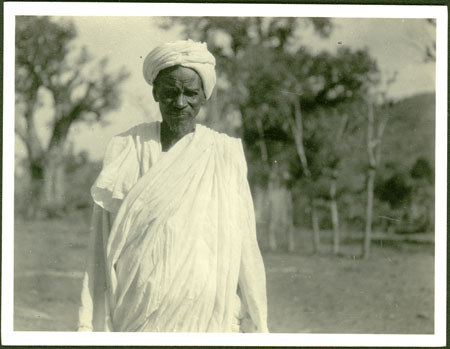Arab man

103 x 76 mm | Print gelatin silver
Date of Print:
Unknown
Previous PRM Number:
EP.D.222
Previous Other Number:
D 1
Accession Number:
1998.344.222.2
Description:
An upper body portrait of a standing man (identified as Omda [Chief] Abdul Gadin Ahmed) wearing Arab dress, probably a man from Jebel Gule encountered by Evans-Pritchard in the vicinity of Tabi massif, since Evans-Pritchard notes that the Omdur had met the Seligman's at Gule in 1910.
Photographer:
Edward Evan Evans-Pritchard
Date of Photo:
1926 November - December
Region:
Blue Nile ?Tabi Hills
Group:
Arab
NamedPerson:
Omda Abdul Gadin Ahmed
PRM Source:
Edward Evan Evans-Pritchard
Acquired:
Donated 1966
Other Owners:
E. E. Evans-Pritchard Collection
Class:
Clothing , Physical Anthropology
Documentation:
Original catalogue lists in Manuscript Collections. Additional material in related documents files. [CM 27/9/2005]
Primary Documentation:
PRM Accession Records - Accession Book Entry [p.
98] 1966.27 [1 - 24] G[ift] PROFESSOR E.
E.
EVANS-PRITCHARD; INST.
OF SOCIAL ANTHROPOLOGY, 51 BANBURY RD.
OXFORD - 1966.27.19 - S.
SUDAN, DARFUNG.
VARIOUS TRIBES.
Box of negatives in envelopes, [1 - 242] & 1966.27.20 - Box of prints of these negatives [refers to object 1966.27.19] [1 - 242], in envelopes.
Manual Catalogues [typewritten, entitled "Ingassana"] - 222. Arab type. D.1
Note on print reverse ms pencil - "The Omdur Abdul Gadin Ahmed said he saw C.G.S. [Charles Gabriel Seligman] & B.Z.S. [Brenda Z. Seligman] at Gebel Gule. D1"
Manual Catalogues [typewritten, entitled "Ingassana"] - 222. Arab type. D.1
Note on print reverse ms pencil - "The Omdur Abdul Gadin Ahmed said he saw C.G.S. [Charles Gabriel Seligman] & B.Z.S. [Brenda Z. Seligman] at Gebel Gule. D1"
Other Information:
The Seligman's visited Jebel Gule in 1910, who said of the place that '[a]t the time of our visit in 1910 the Gule language was disappearing rapidly; the settlement had been decimated by the Khalifa's forces and the young men and women had all been killed or taken captive, so that the population consisted of elderly men who had escaped, and having procured young wives had returned to their village.
The children were growing up to speak Arabic only.' in C.G.
& B.
Seligman's Pagan Tribes of the Nilotic Sudan (London, Routledge 1932) p.418.
[Chris Morton 24/2/2004]
Recorder:
Christopher Morton 24/2/2004 [Southern Sudan Project]

